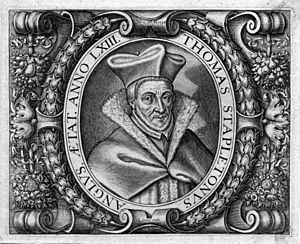Thomas Stapleton (theologian) facts for kids
Quick facts for kids
Thomas Stapleton
|
|
|---|---|
 |
|
| Born | 1535, July 1535 Henfield, Sussex |
| Died | 12 October 1598 Leuven, Spanish Netherlands |
| Alma mater | |
| Occupation | Theologian, university teacher, writer |
| Employer |
|
Thomas Stapleton (born in Henfield, Sussex, in July 1535; died in Leuven on October 12, 1598) was an English Catholic priest. He was known for his strong opinions and debates on religious topics during a time of big changes in England.
Contents
Thomas Stapleton's Life Story
Thomas Stapleton was the son of William Stapleton. He went to school at the Free School in Canterbury, then at Winchester College, and later at New College, Oxford. He became a Fellow at Oxford in 1553.
Leaving England for Religious Freedom
When Elizabeth I became queen, she wanted everyone in England to follow the new Protestant religion. Thomas Stapleton, being a Catholic, chose to leave England instead of changing his beliefs. He first went to Leuven and then to Paris to study theology, which is the study of religious faith.
In 1563, while he was back in England, a bishop named William Barlow asked him to reject the Pope's authority. Stapleton refused. Because of this, he lost his position at Chichester Cathedral. After this, he moved back to Leuven with his father and other family members.
Helping to Start a College in Douai
In 1568, Thomas Stapleton joined Cardinal Allen in Douai. He played a big part in starting the English College there. He helped by teaching and by using his own salary as a theology lecturer to support the college.
He became a public professor of divinity and a canon (a type of priest) at St. Amatus. Along with Allen, he earned his Doctor of Divinity (D.D.) degree on July 10, 1571.
Later Career and Recognition
In 1584, he left these positions to join the Society of Jesus, a Catholic religious order. However, he did not complete his training with them and returned to Douai.
Philip II of Spain appointed him as a professor of Scripture at the Catholic University of Leuven in 1590. He also received a position at St. Peter's Church. Soon after, he became a dean in Hilverenbeeck. He used all the money from these jobs to help English Catholics who were in need.
His reputation as a theologian grew, reaching Rome. Pope Clement VIII admired his writings so much that he had them read aloud during his meals. The Pope invited Stapleton to Rome twice, but he did not go. However, he accepted the Pope's offer to make him a prothonotary Apostolic in January 1597. This was a high position in the Catholic Church.
Many people believed he would become a cardinal, which is an even higher rank. However, some obstacles prevented him from traveling to Rome. He stayed in Leuven until he passed away the following year. He left his books and writings to the English College at Douai. Today, a painting of Thomas Stapleton can be seen at Douai Abbey in England.
Thomas Stapleton's Writings
Thomas Stapleton was a very productive writer. His first works were translations of other important religious texts.
Early Translations and Original Works
- He translated Ven. Bede's "History of the Church in England" (published in Antwerp, 1565).
- He also translated the "Apology of Staphylus" (Antwerp, 1565) and Hosius on "The Expresse Word of God" (1567).
His own original books were numerous and covered many religious topics.
- "A Fortress of the Faith" (Antwerp) is notable for being the first time the term "Huguenots" was used.
- Other works include "A Return of Untruths" (Antwerp, 1566) and "A Counterblast to M. Horne's vain blast" (Louvain, 1567).
Important Theological Books
Stapleton wrote many books on theology, which were important in the religious debates of his time.
- "Orationes funebres" (Antwerp, 1577)
- "Principiorum fidei doctrinalium demonstratio" (Paris, 1578)
- "Speculum pravitatis hæreticæ" (Douai, 1580)
- "De universa justificationis doctrina" (Paris, 1582)
- "Tres Thomæ" (Douai, 1588)
He also wrote a series of books called "Promptuarium morale" (Antwerp, 1591, 1592) and "Promptuarium Catholicum," which included volumes on Sunday Gospels (Cologne, 1592), weekday Gospels (Cologne, 1594), and feast day Gospels (Cologne, 1592).
Later Publications and Collected Works
Some of his later works include:
- "Relectio scholastica" (Antwerp, 1592)
- "Authoritatis Ecclesiasticæ circa S. Scripturarum approbationem defensio" (Antwerp, 1592)
- "Apologia pro rege Philippo II" (Constance, 1592), which he published using a clever pen name, Didymus Veridicus Henfildanus, meaning "Thomas the Stable-toned [truth-speaking] Henfieldite."
He also wrote a series called "Antidota," which included "Antidota Evangelica," "Antidota Apostolica contra nostri Temporis Hæreses" (both Antwerp, 1595), "Antidota Apostolica in Epistolam Pauli ad Romanos" (Antwerp, 1595), and "Antidota Apostolica in duas Epistolas ad Corinthios" (Antwerp, 1598).
His other works include "Triplicatio inchoata" (Antwerp, 1596), "Orationes catecheticæ" (Antwerp, 1598), "Vere admiranda, seu de Magnitudine Romanæ Ecclesiæ" (Antwerp, 1599), "Orationes academicæ miscellaneæ" (Antwerp, 1602), and "Oratio academica" (Mainz, 1608).
All of Thomas Stapleton's works were later collected and republished in four large books in Paris in 1620. This collection also included a short autobiography of Stapleton written in Latin poetry and a biography by Henry Holland.

